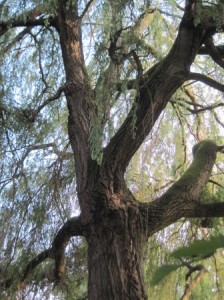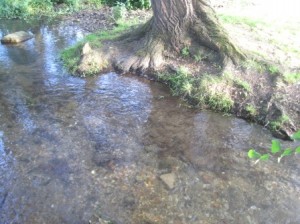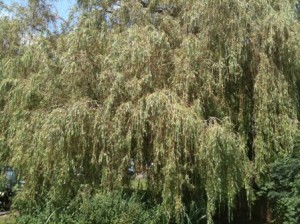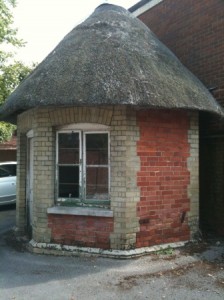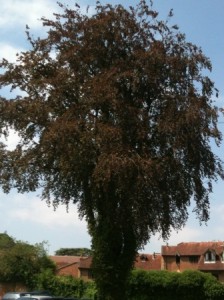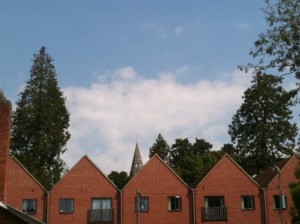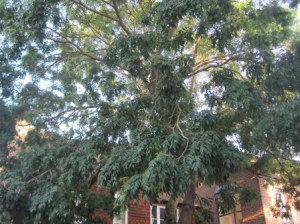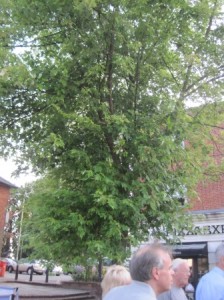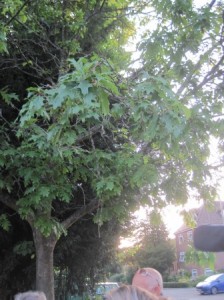We ventured out on a guided walk with Alton’s Tree Warden, Jim Dickinson, on a lovely evening on 21 July 2014 and started in the Community Centre car park. About 20 of us turned up and Jim started with the enormous weeping willow opposite the Library.
He pointed out that the roots of the weeping willow were emerging in the river bed of the River Wey in the Community Centre car park, and that willows will never “drown” in too much water.
He said that this enormous weeping willow was not even fully grown and obviously had plenty of water from the river.
Jim pointed out the thatched roof of a small building in the car park of Lloyds Bank and explained that it had been a dairy where the milkmaid made the butter. Looking through the window the next day I could see the slate shelves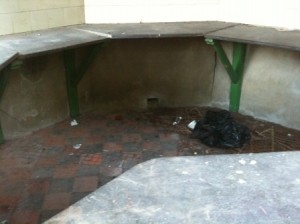
Slate shelves inside the Dairy
We moved into the car park and looked at some of the trees there which were being visibly affected by the tarmac being too close and not enough grass round them – like the Copper Beech to the left.
Jim pointed out to us the trees up on the hill round St Lawrence Church. There was one to the left which was still pointed to the right of the steeple had not been struck by lightning because the conductor on top of the steeple had taken it to earth. The two trees to the right of that and the large one that is nearer have all been struck. – see below and left
We passed through the car park and up Amery Street to outside the Alton Herald offices and there we looked at an Acacia tree which usually grows in the desert with hardly any water to survive on. Ours is in heaven with plenty of water and is growing all the time. In the desert it would be a quarter of the size and only survives by growing roots the size of a human hair 60 metres down to the aquifer under the sand – see below left.
We then moved into the Market Square where Jim pointed out a Canadian Maple which seems to survive even though it is regularly clouted by draymen’s lorries. It was a wonderful lime green colour – see below right.
In the Lady Place car park Jim showed us a couple of oak trees, one with enormous leaves. He also showed us another oak alongside it which grows really quickly but the wood is not at all hard and not really much use in industry. Somebody did find a good use for it though as a bung for beer barrels, which kept the beer in and the fruit fly out – below left
We then walked from the Lady Place car park into the Public Gardens to look at all the wonderful trees planted in there. Jim said that the park was originally the gardens for an Asylum on the High Street near Westbrooke House – not for the insane but for those who were very old and forgetful and who were likely to get lost. He pointed out the little built-up hill in the middle of the park where the people could sit and look out, over the yew hedges that had been planted all around the perimeter of the gardens, and therefore not feel left out. Rather touching really. This of course was in the Victorian era and before. He said that the Victorians never saw their trees fully grown, as we will not see any trees we plant now in their full glory, especially the large species.
Following is a gallery of photos of some of the other trees along our route – most of which I could not remember their names. Jim was marvellous with his information but I was too busy taking photos to write down all the species. If anyone can help me I would love to be able to label them correctly. The Park had some really interesting trees – Jim pointed out different kinds of fir trees and others in the park.
One tree in particular was covered in the most beautiful perfumed blossom. We had seen a small version of it opposite the Community Centre growing in somebody’s garden (please somebody help me with its name). There were some trees (again I need help to remember their names) which had been planted in recent years which had cost a fortune, as they needed to plant fairly adult trees to avoid them being damaged too much by “wear and tear”. They are pictured in another gallery below –
We left the Public Gardens through the gate in Westbrooke Road and walked along towards Lenten Street. We stopped and looked at a Yew tree inside Barton End’s gate – Jim said it was just a baby. He pointed out an enormous Beech in Westbrooke Road which he said was suffering somewhat – it had splits in its bark and showed “stretch marks”. In Lenten Street we walked past a giant Oak tree and stopped at Sir William Curtis’ house – he had been a famous botanist of Victorian times and had planted up his own garden right down to the river (now a car park) and had also planted in his neighbour’s garden – a giant Cedar tree and also a Mulberry which had laid itself on and on down this neighbour’s garden.
Jim was most informative and he tells us he has a couple of different walks that he takes people on – so watch this space.
Click here for reports and pictures of recent visits and other BGs’ news
Click here to return BGs club page
